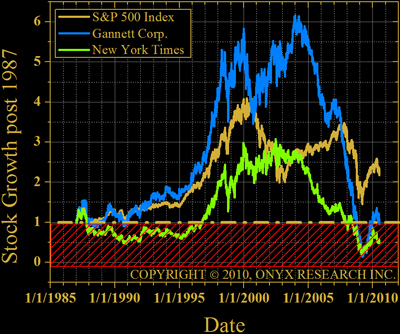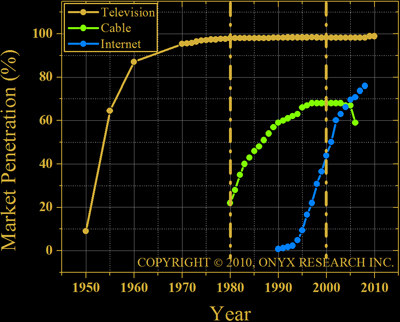_October2013_small-c5284e74ed9ef79f612813617b47061d92bf282e0f0f8ff07179efcb1aa8cc1a.jpg)
|
Research & Analysis for Business and Investment Clients |
|
Figure 4 plots the value of $1 invested in the S&P 500 index vs. Gannett Corporation and The New York Times Company. Through 2005 returns were respectable. As the main ad revenue drivers, retail and classified, diminished returns disappeared. Note that the S&P 500 index dropped precipitously as well. This is not Google's doing. Markets are chaotic.
 Figure 4. S&P 500 Index performance compared to the Gannett Corporation and The New York Times Company. Notably, company stock prices fail to track industry data. Red box
defines negative return on investment. Plots assume $1 investment in 1987. Dashed gold line defines break even threshold.
Figure 4. S&P 500 Index performance compared to the Gannett Corporation and The New York Times Company. Notably, company stock prices fail to track industry data. Red box
defines negative return on investment. Plots assume $1 investment in 1987. Dashed gold line defines break even threshold.
Traditional print media's emerging competitors from 1980 on include cable television and the internet. Note that CNN (a cable news media corporation) was launched 1 June 1980 (see figures 1 & 2). Sergey Brin was ~7 and Larry Page was ~8 years old at the time.
Market penetration data for broadcast television, cable television, and internet are plotted in figure 5. Not surprisingly, as content rich competitors emerge and consumer attention remains constant, advertising dollars going to traditional print media divide.
The new digital print media we see emerging has characteristics no newspaper can provide.
New, quality digital print media is:
(1) Rich. Raw information is distilled into knowledge. Rather than just one article, content links to other quality content. Further, publishers can embed rich audio and video.
(2) Relevant. Information is useful to you. If you're looking for knowledge on nanotechnology, the best knowledge should rise to the top, quickly. Try to keyword search your printed newspaper. This applies to ads too. Direct-to-consumer marketing and ads matching content beat "Pay & Pray".
 Figure 5. US Television, cable, and internet market penetration statistics. Dotted lines mark significant cable television penetration from 1980-1990 and significant internet penetration by 2000.
Figure 5. US Television, cable, and internet market penetration statistics. Dotted lines mark significant cable television penetration from 1980-1990 and significant internet penetration by 2000.
(3) Dynamic. Content is updated and current. As a story emerges, new knowledge is added to existing knowledge. Think trends, not ephemeral instant gratification.
(4) Data Driven. Investing time should yield a return. Without metrics, what exactly are you doing? How can you make an informed decision?
Digital print media businesses will grow and new business models will emerge. Valuable information will find valued customers. As an example, review the QuinStreet business model. Though not yet applied to public information, statistical tools like those developed by Crowdcast can bring metrics to on-line information.
Distinct from business driven content, investigative journalism, requires a different funding model. Just as the police are provided at taxpayer expense, federal, state, and local government should consider allocating resources to vetted journalists.
No one disputes the value of the police (in general). Quality journalism policing for large-scale nefarious behavior is consistent with societal stability.
Whether business motivated or socially responsible, rich, relevant, dynamic, data driven content will have an audience seeking intelligent insight.
We believe Google's corporate goals are similarly consistent. We blame cable television and the internet for traditional print media tribulation.
References: (1) Ad revenue numbers derived from NAA publications. Analysis by Onyx Research.
(2) Market data derived from public sources. Analysis by Onyx Research.
Looking for knowledge unique to your needs? Click on the Onyx Premier Black icon below.

